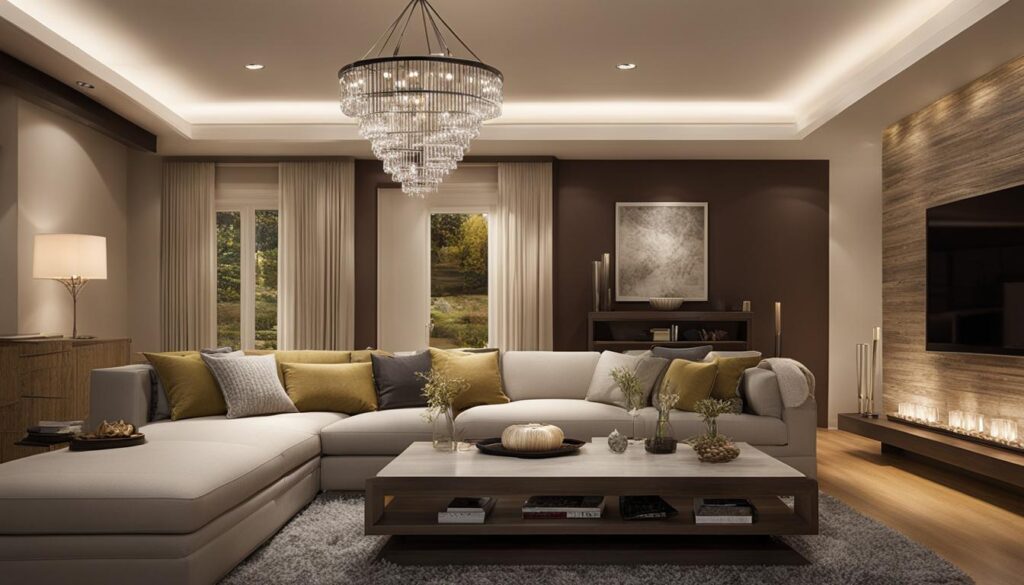When it comes to creating the perfect lighting in your living room, recessed lighting can be an excellent choice. This type of lighting not only adds a modern and sleek look to your space but also provides versatility in terms of lighting options. Whether you want to achieve general illumination or highlight specific areas or objects, recessed lighting can help you achieve the desired effect.
Before you start installing recessed lights, it’s important to consider the placement. Here are some tips to help you position your recessed lighting in the living room:
- Consider the type of lighting you want to achieve, whether it’s general lighting, task lighting, or accent lighting.
- For general lighting, evenly space and align the lights across the ceiling.
- For task lighting, focus the lights on specific work surfaces or areas where you need concentrated light.
- When using accent lighting, place the lights strategically to highlight certain features or objects in the room.
- Avoid placing recessed lights directly above furniture to prevent glare.
- Take into account the size of your living room, the placement of your furniture, and the height of your ceilings to plan the layout effectively.
- Consider using a mixture of light bulbs and installing a dimmer switch for added versatility and control over the lighting ambiance.
Table of Contents
Key Takeaways:
- Choose the type of lighting you want to achieve: general, task, or accent lighting.
- Properly space and align recessed lights for general lighting.
- Focused task lighting should be directed at specific work surfaces or areas.
- Strategically place accent lighting to highlight features or objects.
- Avoid placing lights directly above furniture to prevent glare.
Tips for Proper Recessed Lighting Placement
When it comes to achieving the best placement for recessed lighting in your living room, there are a few key tips to keep in mind. By following these guidelines, you can create a well-lit and visually appealing space that meets your specific lighting needs.
Consider Your Lighting Layout
Before you start installing recessed lights, take the time to plan out your lighting layout. Consider the different areas of your living room that you want to illuminate, such as seating areas, work surfaces, or architectural features. By identifying these focal points, you can strategically position your recessed lights to highlight them effectively.
“The proper placement of recessed lights is crucial in achieving optimal lighting in your living room.”
Follow the Spacing Guidelines
Spacing your recessed lights correctly is essential to avoid shadows and create an inviting atmosphere. As a general rule, aim to space the lights roughly half the height of your ceiling apart. For example, if your ceiling is 9 feet high, space the lights about 4.5 feet apart. Adjust this spacing based on the brightness of your lights and the desired lighting effect.
Consider Additional Lighting Needs
If you find that the initial placement of recessed lights doesn’t provide sufficient illumination, don’t be afraid to add more lights. However, be mindful not to overdo it and create an overly bright or cluttered space. Aim for a balanced distribution of light throughout the room.
By following these tips for proper recessed lighting placement, you can create a well-designed and functional lighting layout in your living room. Remember to consider your lighting goals, adhere to spacing guidelines, and adjust as needed to achieve the desired ambiance. With the right placement, your recessed lighting will enhance the overall atmosphere and aesthetics of your living room.
Conclusion
Proper placement of recessed lights is crucial for creating an ideal living room lighting design. By considering factors such as the size of the room, the placement of furniture, and the height of the ceilings, you can achieve optimal lighting that enhances the space.
When positioning your recessed lights, it’s important to find the ideal distance between them. Following the ceiling height rule of thumb, which suggests spacing the lights roughly half the height of the ceiling apart, can help create a balanced and inviting atmosphere. Paying attention to spacing will also ensure that there are no shadows in the corners of the room.
Additionally, using a mixture of light bulbs and installing a dimmer switch provides versatility in lighting options and allows you to control the ambiance of the room. By sketching a lighting plan and choosing a focal point, you can create a well-planned layout that highlights architectural features or specific work surfaces.
In conclusion, with careful consideration of these factors and by following the tips for proper recessed lighting placement, you can design a living room lighting layout that not only meets your unique preferences but also enhances the overall atmosphere of the space.
FAQ
How do I determine the type of lighting I want in my living room?
Consider whether you want general lighting, task lighting, or accent lighting in your living room. Each type requires a different layout.
Should recessed lights be placed directly above furniture?
No, it’s best to avoid placing recessed lights directly above furniture to prevent glare.
What should I consider when planning the layout of recessed lighting?
Consider the size of your living room, the placement of your furniture, and the height of your ceilings when planning the layout of your recessed lighting.
How can I create the perfect ambiance with recessed lighting?
Consider using a mixture of light bulbs and installing a dimmer switch to create the perfect ambiance for any occasion.
How do I ensure proper placement of recessed lighting in my living room?
Start by sketching a lighting plan, measure furniture and areas where you spend the most time, choose a focal point, follow the ceiling height rule of thumb, and pay attention to spacing to avoid shadows and create a more inviting atmosphere.
Is there a limit to the number of recessed lights I can install?
You can add additional recessed lights if needed, but be mindful not to overdo it and create an excessive amount of lighting.
What is the importance of proper placement of recessed lights?
Proper placement of recessed lights is essential for achieving optimal lighting in your living room. It helps create a well-lit space that meets your needs and enhances the overall design of the room.


